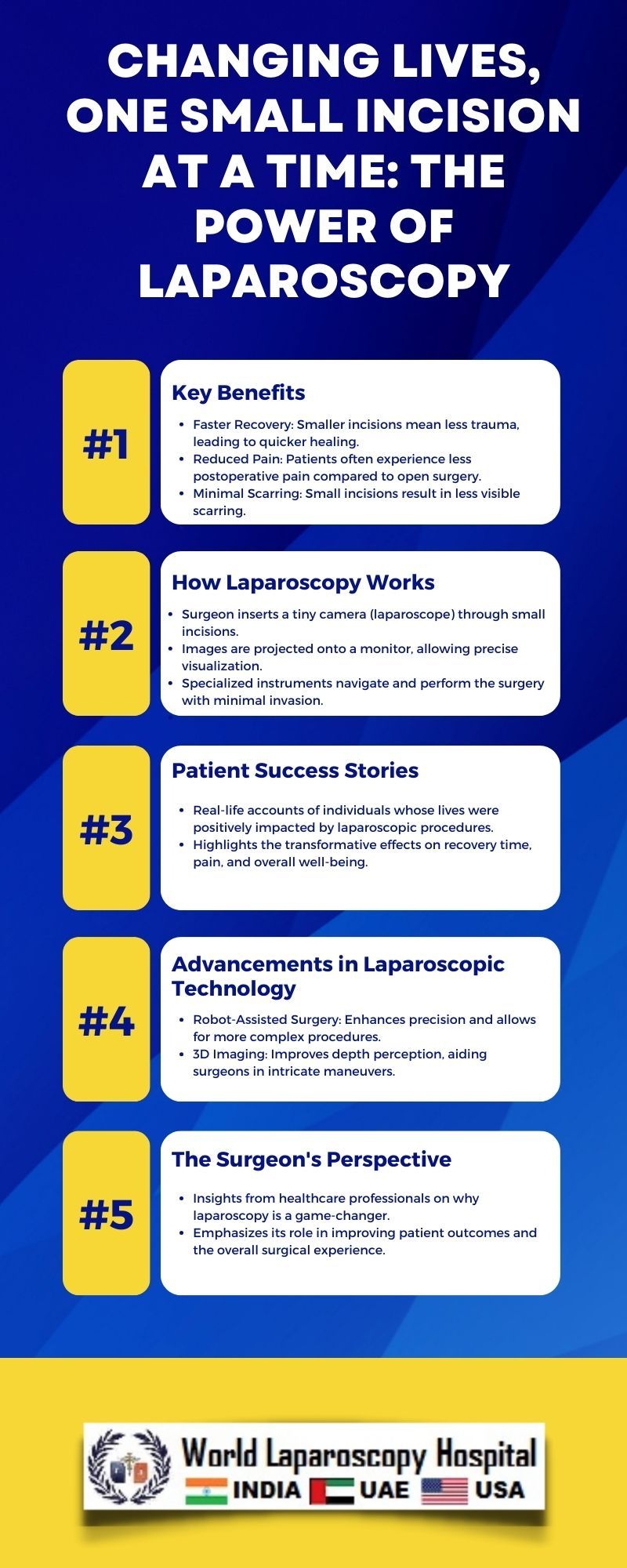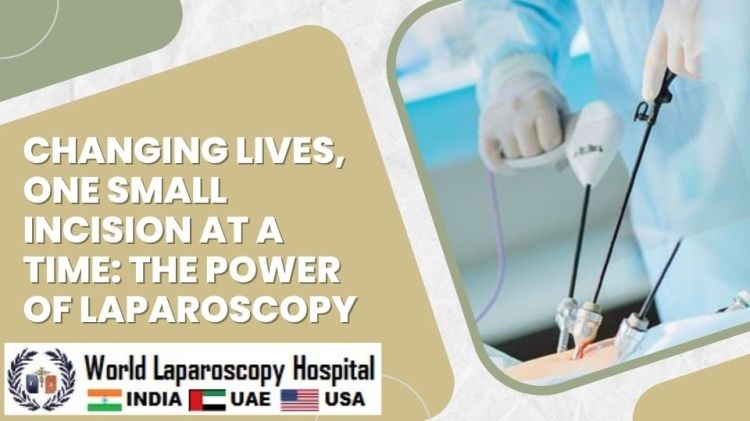Changing Lives, One Small Incision at a Time: The Power of Laparoscopy
Introduction
In the realm of medical advancements, one technology has emerged as a transformative force, revolutionizing the landscape of surgical procedures and patient outcomes. Laparoscopy, often referred to as minimally invasive surgery, has become a cornerstone in modern medicine, enabling surgeons to change lives with precision and minimal disruption. This article delves into the depths of laparoscopy, exploring its history, the mechanics behind the procedure, and the profound impact it has on patients' lives.

A Glimpse into the Past
Before the advent of laparoscopy, traditional open surgery was the norm, characterized by large incisions that often led to extended recovery times, increased pain, and higher risks of complications. The desire for less invasive techniques to reduce patient morbidity and improve recovery times sparked the development of laparoscopy in the early 20th century.
The first attempts at laparoscopy date back to the early 1900s, with the use of rudimentary instruments and rigid scopes. However, it wasn't until the latter half of the century that technological advancements allowed for the refinement of laparoscopic procedures. The introduction of fiber-optic technology in the 1960s paved the way for flexible endoscopes, enabling surgeons to navigate the intricate internal structures of the body with greater ease.
The Mechanics of Laparoscopy
Laparoscopy involves the use of a laparoscope – a long, slender tube equipped with a light source and a camera. This device is inserted into the body through small incisions, typically ranging from 0.5 to 1.5 centimeters in length. The camera transmits high-definition images to a monitor, providing surgeons with a magnified and detailed view of the surgical site.
Additionally, specialized instruments are introduced through additional small incisions, allowing surgeons to perform intricate maneuvers with remarkable precision. These instruments are manipulated by the surgeon, guided by the real-time visual feedback provided by the laparoscope. The combination of advanced optics and precision instruments has elevated laparoscopy to the forefront of modern surgical techniques.
The Versatility of Laparoscopy
Laparoscopy's versatility extends across various medical specialties, ranging from general surgery to gynecology, urology, and even orthopedics. In general surgery, procedures such as appendectomies, cholecystectomies, and hernia repairs are commonly performed using laparoscopic techniques. Gynecologists employ laparoscopy for hysterectomies, ovarian cyst removals, and tubal ligations, among other procedures.
Urologists harness the power of laparoscopy for kidney surgeries, prostatectomies, and bladder surgeries, while orthopedic surgeons have explored its applications in joint surgeries. The adaptability of laparoscopy allows for a broad spectrum of procedures, reducing the need for extensive incisions and minimizing the impact on patients' lives.
Patient Benefits and Improved Outcomes
The shift towards laparoscopy has yielded significant benefits for patients, contributing to improved outcomes and enhanced overall experiences. One of the primary advantages is the reduced trauma to the body. Traditional open surgeries necessitate large incisions, leading to increased blood loss, higher risk of infections, and prolonged recovery times. In contrast, laparoscopic procedures involve small incisions, minimizing blood loss, lowering the risk of infections, and accelerating the recovery process.
Furthermore, the cosmetic aspect cannot be overlooked. The smaller incisions associated with laparoscopy result in less scarring, promoting better aesthetic outcomes and improved patient satisfaction. Patients are not only spared from the physical discomfort of large scars but also benefit from the psychological impact of minimal scarring, contributing to a positive postoperative experience.
The shorter hospital stays associated with laparoscopy are a testament to the efficiency of this technique. Patients undergoing laparoscopic procedures often experience shorter recovery times, allowing them to resume their normal activities more quickly than their counterparts who undergo open surgeries. This has far-reaching implications for healthcare systems, reducing the burden on hospitals and freeing up resources for other patients in need.
Pioneering Laparoscopic Innovations
As laparoscopy continues to evolve, pioneering surgeons and researchers are pushing the boundaries of what is possible. Robotics have entered the realm of minimally invasive surgery, with robotic-assisted laparoscopy gaining popularity in recent years. These systems provide surgeons with enhanced dexterity, precision, and the ability to perform complex maneuvers with greater ease.
Additionally, advancements in imaging technologies, such as three-dimensional (3D) laparoscopy, are enhancing the depth perception and spatial awareness of surgeons during procedures. This not only facilitates more accurate surgeries but also reduces the learning curve for less experienced surgeons, further democratizing the benefits of laparoscopy.
Challenges and Considerations
While laparoscopy has undeniably transformed the landscape of surgical interventions, challenges and considerations persist. One notable challenge is the initial learning curve associated with mastering laparoscopic techniques. Surgeons accustomed to traditional open procedures may need to undergo specialized training to adapt to the nuances of laparoscopy.
Moreover, the cost of laparoscopic equipment and the initial setup for a laparoscopic program can be substantial. Smaller healthcare facilities may face financial barriers when seeking to adopt laparoscopic techniques, potentially limiting patient access to these advanced procedures.
In certain cases, patient factors such as obesity or complex medical conditions may pose challenges for laparoscopic interventions. Surgeons must carefully assess individual cases to determine the most appropriate approach, considering factors such as the patient's overall health, anatomy, and the nature of the surgical procedure.
Future Directions and Global Impact
As technology continues to advance, the future of laparoscopy holds promise for even greater innovations. The integration of artificial intelligence (AI) into laparoscopic procedures could enhance decision-making during surgeries, providing real-time insights and improving surgical precision. AI-driven systems may also contribute to automated tasks, further streamlining the surgical process.
On a global scale, the impact of laparoscopy extends beyond individual patient experiences. The reduced healthcare costs associated with shorter hospital stays and decreased postoperative complications can contribute to more sustainable healthcare systems. Laparoscopy has the potential to bridge healthcare disparities, making advanced surgical techniques more accessible to a broader range of patients around the world.
Conclusion
In the world of medicine, the evolution of surgical techniques has been a journey marked by innovation and continuous improvement. Laparoscopy, with its small incisions and transformative capabilities, stands as a testament to human ingenuity in the pursuit of enhancing patient care. From its humble beginnings to the forefront of modern surgical practices, laparoscopy has changed lives, one small incision at a time.
As we look toward the future, the ongoing refinement of laparoscopic techniques, coupled with emerging technologies, promises to further elevate the standard of care for patients worldwide. The power of laparoscopy lies not only in its ability to navigate the intricate internal landscape of the human body but also in its capacity to redefine what is possible in the field of surgery. Through the lens of laparoscopy, the future of medicine appears brighter, more precise, and filled with the potential to change countless lives for the better.
